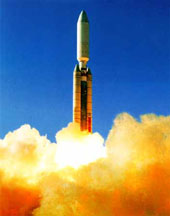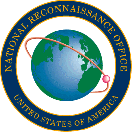 A Lockheed Martin [LMT] Titan IVA space launch vehicle
A Lockheed Martin [LMT] Titan IVA space launch vehicle carrying a classified National Reconnaissance Office
(NRO) payload exploded shortly after it was launched
yesterday at Cape Canaveral, Fla.
By Kyle Crosby
 A Lockheed Martin [LMT] Titan IVA space launch vehicle
A Lockheed Martin [LMT] Titan IVA space launch vehicle
carrying
a
classified National Reconnaissance Office
(NRO) payload exploded
shortly after it was launched
yesterday at Cape Canaveral,
Fla.
An Air Force statement said the rocket began to
self-destruct
40
seconds after it was launched from
Space Launch Complex 41.
Air Force safety officials sent self-destruct signals to
the
Titan IV about two seconds later to break up the rocket
and reduce
potential
damage from debris.
The destroyed Titan IVA rocket was worth about $400 million
and
the NRO payload was valued at just under $1 billion dollars,
officials
said. The launch was to have been the Air Force's last Titan
IVA
mission.
Debris from the explosion landed safely in the ocean about
one-half
a mile offshore, the service added. There were no injuries
or damage
to launch facilities on private property nearby.
"[The Air Force's] emergency plans all went well; everything
went
as expected in case of an explosion," said Lt. Col. Don Miles,
a
spokesman for the Air Force Space Command (SPACECOM) at
Peterson AFB, Colo.
Brig. Gen. Randall Starbuck, commander of the 45th Space Wing
at nearby Patrick AFB, Fla., said at a press conference that
three
groups were being created to investigate the explosion.
The first group, an Engineering Analysis Team led by Lockheed
Martin, will gather engineering data from the explosion for
the
other two groups. The second group, the Accident Investigation
Board, led by Maj. Gen. Robert Hinson of SPACECOM, will
prepare an accident report for public release. The third
second,
a Safety Investigation Board, led by a colonel from the 30th
Space Wing at Vandenberg AFB, Calif., will produce a confidential
report on its findings.
 All Titan launches will be postponed until the boards are
satisfied
All Titan launches will be postponed until the boards are
satisfied
that the launch vehicles are safe, according to Evan McCollum,
a Lockheed Martin spokesman. Both he and Miles agreed
that it is too early to say what effect the explosion will
have on
future launches.
Before yesterday's mishap, the next Titan IV launch, of a
Titan
IVB, was scheduled for Dec. 18 at Cape Canaveral.
The Titan IV that exploded yesterday had already been delayed
from its original July 25 launch date because of a tear in
the
covering of the rocket's Centaur upper-stage motor. Another
Titan IV carrying a NRO payload was delayed several months
last year because of a nitrogen-tetroxide leak. The last
explosion
of a Titan IV rocket was at Vandenberg AFB, Calif.,
in August 1993.
Despite these recent problems, officials are confident Titan
can
successfully carry out future missions.
"We see no reason not to [use Titan IVs] in the future," said
Rick Oborn, a spokesman for the NRO. Miles added that it's
"too early to say what relation [the Titan IVA explosion]
has
to other Titans." All future launches will be on the newer
Titan IVB.
The Titan IV is the most powerful unmanned launch vehicle
in the United States. It is used to launch military payloads.
The
Titan IVA was first launched June 14, 1989, and the Titan
IVB
was first launched Feb. 23, 1997. Before yesterday's accident,
the Titan had an overall success rate of 95 percent.


